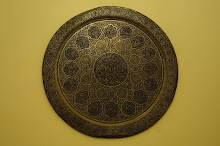
"Seville feels very Arab," I recently told a Sevillian. "What do you mean 'feels'?", he responded. "We ARE Arabs."
This quintessential Spanish Andalusian city does indeed feel very Arab, with an enigmatic oriental spirit, a sense of cunning and a joie de vivre found among its residents. The city holds this spirit despite the echoes of the Inquisition and its very Christian and Catholic past demonstrated yearly in the spooky marches of Semana Santa - with capes, cones, and all.
Seville, once Arab 'Ishbilia', and before that, the Roman 'Hispalis', is a city that during the right season appears like a collection buildings strewn about a large orange orchard with cobbled streets. Some of the remaining Moorish city walls can be seen from the top of the Giralda, the massive minaret turned steeple. The walls embrace and contain this large urban space situated on the Guadalqivir River (from Arabic 'Wadi El Kebir' or the Big Valley). It is here, where the river stops being navigable for ocean-going ships - a convenient stopping point - that Seville was founded.
In the rabbit warren of low rise buildings below the Giralda, a rich history unfolded: Yemenis rose up against the great Abdel Rahman I, the exiled Umayyad king from Damascus; it is where sailors readied to sail to the Americas and drank themselves to oblivion, as many still do today in the Sevillian night; and where the great Ibn Khaldun came to look for his family's roots.

The city was the setting for the infamous Don Juan, from the play the "Trickster (Burlador) of Seville" by Tirso de Molina. Seville was also the centre of the "poetry mad" Abbadids - Muslim strongmen of the 11th century, and rivals of the rulers of Toledo. It remains today a centre for play and cunning.
Many things in Seville are interestingly odd. The city's motto, on its flag, is NO8DO. The "8" apparently represents yarn, or "madeja" in Spanish. The motto when read aloud would be "NO madeja DO" mirroring the words "No me ha dejado" or "it has not abandoned me."
 The city's apparent oddness comes from its succesful mix of cultures: the mosque turned cathedral, the minaret turned steeple, the Andalusian Arabs turned Andalusian Spanish, and Hispalis turned Ishbilia turned Sevilla. Castillian monarchs even decorated their palaces with the Muslim inscription: "Wa la ghalib ill Allah" which translates to "There is no Victor but God".
The city's apparent oddness comes from its succesful mix of cultures: the mosque turned cathedral, the minaret turned steeple, the Andalusian Arabs turned Andalusian Spanish, and Hispalis turned Ishbilia turned Sevilla. Castillian monarchs even decorated their palaces with the Muslim inscription: "Wa la ghalib ill Allah" which translates to "There is no Victor but God". This is indeed still today an 'Arab' city. It is mysterious, on the edge, and full of street humour and trickster-like personages. Like most matters in Seville, the Giralda has a twist: it was built with a ramp, not stairs, to reach its distant top. For centuries, early in the morning, Sevillians would hear the sound of horseshoes on cobble stone as the Muezzin rode horseback up the tower to sound the call to prayer.














No comments:
Post a Comment